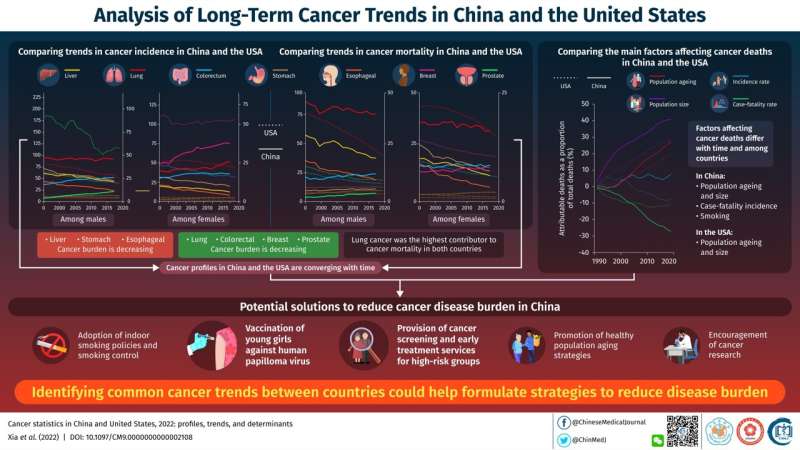Inferences drawn from a narrowing gap between cancer profiles highlights converging cancer trends, and how China could reduce its disease burden. Credit: Chinese Medical Journal
The overall burden of cancer has gradually increased in China in recent years. By comprehensively examining data from multiple large databases, researchers have elucidated the similarities and differences between cancer epidemiology in China and the USA. Their findings reveal that cancer profiles in these two countries are converging. Hence, cancer screening and prevention strategies adopted by the USA could also help China actively control its cancer burden.
Cancer is currently the most common cause of death in most developed countries around the world. In the USA, comprehensive progress in cancer research, prevention, and care has resulted in reduced rates of cancer since the 1990s, indicating that these strategies could also benefit other countries, such as China, where the cancer burden is steadily increasing. However, the effectiveness of cancer prevention strategies is highly dependent on cancer epidemiology (i.e., the trends in the incidence, distribution, causative factors, etc. of these diseases)—which can vary from country to country. Hence, a comparative analysis of long-term trends in cancer incidence and mortality is warranted before their adoption.
To provide some answers, researchers from the Chinese Academy of Medical Sciences and Peking Union Medical College performed a large-scale comparative study of cancer trends in China and the USA, using open-source data. Their study, which was made available online on 9 February 2022, in the Chinese Medical Journal, provides an updated insight into cancer epidemiology in China and the USA. First, the researchers calculated the possible number of cancer cases and deaths in 2022, based on cancer estimates from GLOBOCAN 2020 and population estimates from the United Nations. Trends in cancer incidence and mortality in the USA were analyzed based on information from the SEER and National Center for Health Statistics databases, while data on Chinese patients was obtained from cancer registry reports.
The results collated by the research group point to changing trends of cancer in China. According to estimates, China will witness 4.82 million new cases of cancer and 3.21 million cancer deaths in 2022.
In terms of cancer types, lung cancer is the most common in China, and breast cancer in the USA. The overall findings also showed intriguingly inverse epidemiologic trends in cancer rates amongst these countries. While the incidence and mortality of liver, stomach and esophageal cancer has reduced in China, that of liver cancer has significantly risen in the USA. Conversely, the incidence and mortality of colorectal cancer has risen in China, while that of lung and colorectal cancer has dropped in the USA.
A gender-related disparity was also seen, with lung cancer in China and prostate cancer in the USA being the most commonly diagnosed cancers among men; and breast cancer being the most commonly diagnosed cancer among women in both countries. In both these countries, however, lung cancer continues to be the leading cause of death.
To further understand the specific factors influencing the burden of cancer deaths in China and the USA, the researchers analyzed data from the Global Burden of Disease 2019. Incremental cancer deaths from 1991 to 2019 were analyzed and attributed to four major factors: population aging, population size, age-specific cancer incidence, and the mortality–to–incidence ratio from a particular type of cancer (or its case-fatality rate).
The increase in the ≥25-year-old population appeared to be the primary contributor to rising cancer deaths, while aging may become the most important determinant of cancer disease burden in the future. The case-fatality rate was found to be reducing in both countries, especially in the recent years in China.
The primary contributors to reduced cancer mortality in the USA over the last 30 years have been improved cancer screening methods and newly developed cancer treatments. The appreciable dip in the number of smokers, too, continues to reduce the burden of lung cancer and other tobacco-related cancers in the USA. Further, diagnostic advances and more sophisticated chemotherapeutic, surgical, and targeted treatment strategies have significantly reduced cancer burden in the country.
The findings from this study paint a picture of converging cancer trends in China and the USA, demonstrating that cancer profiles in China are becoming more like those in the USA. China could, therefore, initiate certain cancer prevention and screening strategies–like efforts towards cancer research, smoking control, early diagnosis, and early treatment–along with a focus on healthy aging. These strategies, which have proven effective in reducing the disease burden elsewhere, might prove effective in China as well. Therefore, China should adopt indoor smoking policies, vaccinate girls aged 9–14 against the human papilloma virus, and provide cancer screening and early treatment services for high-risk groups. The promotion of policies for healthy population aging—an important driver of growth—could also benefit China's fight against cancer.
More information: Changfa Xia et al, Cancer statistics in China and United States, 2022: profiles, trends, and determinants, Chinese Medical Journal (2022). DOI: 10.1097/CM9.0000000000002108
Provided by Cactus Communications
























